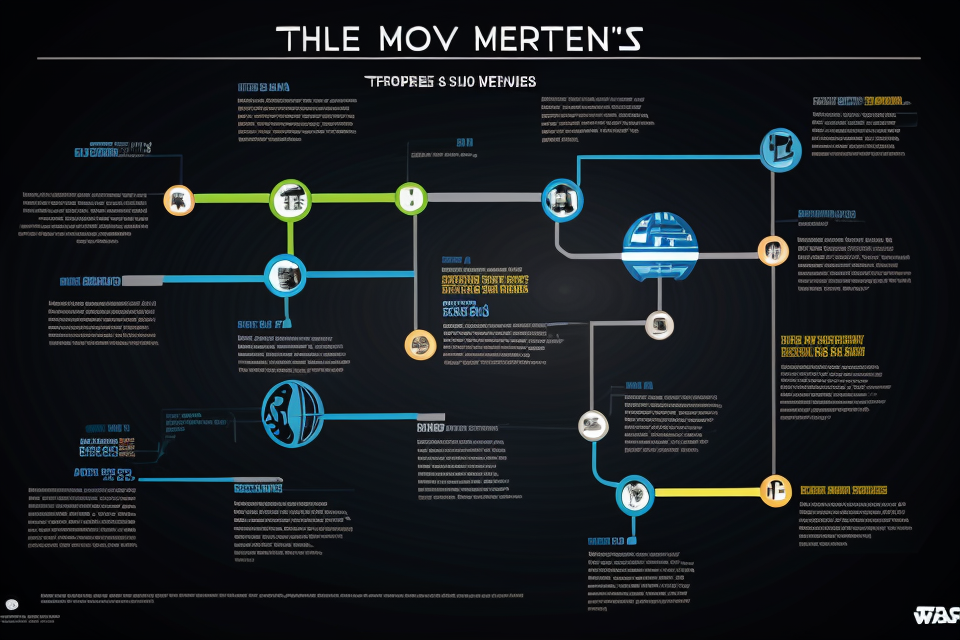Star Wars, the epic space opera that has captured the hearts and imaginations of audiences worldwide, began its journey in a galaxy far, far away in 1977. Created by the visionary mind of George Lucas, the franchise has since spawned multiple films, spin-offs, and merchandise, solidifying its place as a cultural phenomenon. This comprehensive timeline will explore the origins of the Star Wars saga, tracing its evolution from its humble beginnings to its current status as a pop culture icon. Get ready to embark on a journey through space and time as we uncover the fascinating history of Star Wars.
The Origins of Star Wars
The Inspiration Behind the Galactic Saga
George Lucas, the creator of the Star Wars franchise, drew inspiration from several sources when developing the iconic space opera. These sources include mythology, literature, and classic film genres.
Mythology
Lucas was heavily influenced by the works of Joseph Campbell, a renowned mythologist who studied the structure of myths and legends across cultures. Campbell’s work, “The Hero with a Thousand Faces,” explores the monomyth, a narrative pattern found in many myths and stories. Lucas incorporated this pattern into the Star Wars saga, with characters like Luke Skywalker following a hero’s journey.
Literature
Lucas also drew from various literary sources, such as the works of H.G. Wells and Jules Verne. The epic space battles and futuristic technology in Star Wars are reminiscent of the science fiction novels of these authors. Additionally, Lucas was inspired by the serialized adventure films of the 1930s and 1940s, which featured larger-than-life heroes and villains, cliffhanger endings, and daring escapades.
Classic Film Genres
Lucas incorporated elements from classic film genres, such as the Western and samurai films, into the Star Wars universe. The desert planet Tatooine, for example, bears similarities to the Western frontier, with its rugged landscapes and lawlessness. The lightsaber duels and the Jedi code of honor are inspired by samurai films, with their emphasis on discipline, honor, and the pursuit of perfection.
By blending these various sources of inspiration, George Lucas created a unique and enduring universe that has captured the imaginations of audiences worldwide.
The Conceptualization of the Original Trilogy
In the early 1970s, filmmaker George Lucas began work on a science fiction film that would eventually become the first installment in the Star Wars franchise. Lucas drew inspiration from a variety of sources, including classic film serials, Japanese samurai films, and mythology. He initially envisioned a film titled “The Star Wars,” which would be set in a galaxy far, far away and feature epic space battles, daring heroes, and memorable villains.
Lucas began developing the story and characters for the film, creating a detailed backstory for the galaxy in which the story would take place. He also created a rough draft of the script, which featured a young farm boy named Luke Skywalker, a wise old Jedi named Obi-Wan Kenobi, and a menacing villain named Darth Vader.
Over the next several years, Lucas continued to refine the story and characters, working on the script and designing the visual look of the film. He drew inspiration from a variety of sources, including Japanese art and mythology, to create the distinctive look of the Star Wars universe.
In 1975, Lucas received funding from 20th Century Fox to begin production on the film. He assembled a team of artists, designers, and special effects experts to bring his vision to life. Filming began in 1976, and the resulting film, titled “Star Wars: Episode IV – A New Hope,” was released in 1977 to widespread critical and commercial success.
The success of the first film led Lucas to begin work on a sequel, which would eventually become “The Empire Strikes Back.” He continued to develop the story and characters of the Star Wars universe, introducing new characters like Yoda and Lando Calrissian, and expanding on the backstory of existing characters like Han Solo and Leia Organa.
The second film in the original trilogy was released in 1980, and it was similarly well-received by audiences and critics. With the success of the first two films, Lucas began work on the final installment of the original trilogy, “Return of the Jedi.”
“Return of the Jedi” was released in 1983, bringing the original trilogy to a close. The film marked the conclusion of the story that had begun with “A New Hope,” and it introduced several new characters and plotlines that would be explored in later films.
The Release of the Original Trilogy
Episode IV: A New Hope (1977)
- Background:
- Creator: George Lucas
- Influences: Flash Gordon, The Hidden Fortress, and World War II
- Purpose: To create a film that would appeal to both children and adults
- Production:
- Filmed in England, with a budget of $11 million
- Principal photography began in May 1976 and lasted for 16 weeks
- Lucas used groundbreaking visual effects and sound design
- Story:
- The film takes place “a long time ago in a galaxy far, far away”
- The Rebel Alliance, led by Princess Leia, seeks to destroy the Death Star
- Luke Skywalker, a young farm boy, discovers he has a connection to the Force
- With the help of smugglers Han Solo and Chewbacca, they rescue Leia and attempt to destroy the Death Star
- Cast:
- Mark Hamill as Luke Skywalker
- Harrison Ford as Han Solo
- Carrie Fisher as Princess Leia
- Peter Cushing as Grand Moff Tarkin
- Alec Guinness as Obi-Wan Kenobi
- James Earl Jones as Darth Vader
- Impact:
- The film was a commercial success, grossing over $775 million worldwide
- It received positive reviews from critics and audiences alike
- Launched a franchise that would become a cultural phenomenon
- Inspired a new generation of filmmakers and storytellers
Episode V: The Empire Strikes Back (1980)
The Empire Strikes Back, also known as Episode V, is the second film in the original Star Wars trilogy. It was released in 1980, two years after the first film, A New Hope. The film was directed by Irvin Kershner and written by Leigh Brackett and Lawrence Kasdan.
The story of The Empire Strikes Back takes place three years after the events of A New Hope. The Rebel Alliance is on the run from the Galactic Empire, and the protagonist, Luke Skywalker, is training with Jedi Master Yoda on the swampy planet of Dagobah. Meanwhile, the Empire, led by Darth Vader, is searching for the Rebels’ new base.
The film was a critical and commercial success, with praise for its storytelling, visual effects, and musical score. It grossed over $538 million worldwide and was nominated for several awards, including an Academy Award for Best Visual Effects.
One of the most memorable scenes in The Empire Strikes Back is the famous “I am your father” revelation between Luke Skywalker and Darth Vader. This moment was a major plot twist that left audiences shocked and has since become a pop culture reference.
Overall, The Empire Strikes Back is considered one of the best films in the Star Wars franchise and a classic in science fiction cinema.
Episode VI: Return of the Jedi (1983)
- Release Date: May 25, 1983
- Director: Richard Marquand
- Screenplay: Lawrence Kasdan and Leigh Brackett
- Cast: Mark Hamill, Harrison Ford, Carrie Fisher, Billy Dee Williams, Anthony Daniels, and Ian McDiarmid
- Music: John Williams
- Budget: $32.5 million
- Box Office: $475.1 million
Return of the Jedi marked the end of the original Star Wars trilogy and the conclusion of the story that began with A New Hope and continued with The Empire Strikes Back. The film’s title refers to the return of the legendary Jedi master Yoda, who plays a crucial role in the final battle against the Empire.
The film picks up where The Empire Strikes Back left off, with Luke Skywalker (Mark Hamill) continuing his training with Yoda on the swampy planet of Dagobah. Meanwhile, Han Solo (Harrison Ford) and Princess Leia (Carrie Fisher) are on the run from the Empire, with Han trying to evade bounty hunters while also searching for a way to destroy the second Death Star.
As the story unfolds, Luke faces a series of challenges as he trains with Yoda, including a climactic confrontation with the Emperor (Ian McDiarmid) himself. Meanwhile, Han and Leia, along with Chewbacca (Peter Mayhew) and C-3PO (Anthony Daniels), embark on a dangerous mission to destroy the Death Star’s power source, the Emperor’s throne room, and the Emperor himself.
The film was directed by Richard Marquand and written by Lawrence Kasdan and Leigh Brackett, with John Williams returning to compose the score. Return of the Jedi was a critical and commercial success, grossing over $475 million worldwide and solidifying its place as a beloved classic of the Star Wars franchise.
The Expansion of the Star Wars Universe
The Prequel Trilogy (1999-2005)
The Prequel Trilogy, consisting of the films Episode I: The Phantom Menace (1999), Episode II: Attack of the Clones (2002), and Episode III: Revenge of the Sith (2005), is set 32 years before the events of the original trilogy. This trilogy provides a deeper exploration of the galaxy far, far away and sheds light on the rise of the evil Empire and the fall of the Republic.
Episode I: The Phantom Menace
- Release date: 1999
- Storyline: The film follows Jedi Knight Qui-Gon Jinn and his Padawan apprentice Obi-Wan Kenobi as they try to protect Queen Amidala of the planet Naboo from the evil Trade Federation. They discover a young boy named Anakin Skywalker, who is believed to be the Chosen One, destined to bring balance to the Force.
Episode II: Attack of the Clones
- Release date: 2002
- Storyline: Ten years after the events of The Phantom Menace, Anakin Skywalker is now a teenager and the galaxy is on the brink of war. The Jedi Order sends Obi-Wan Kenobi and Anakin Skywalker to investigate the mysterious assassination of Senator Padmé Amidala’s father. This mission leads them to uncover a secret plot by the Sith Lord Darth Sidious and his apprentice, Count Dooku.
Episode III: Revenge of the Sith
- Release date: 2005
- Storyline: The final installment of the prequel trilogy depicts the fall of the Republic and the rise of the Empire. The Jedi Order is betrayed by one of their own, Order 66, and the Sith Lord Darth Sidious and his apprentice, Anakin Skywalker, execute a plan to overthrow the Jedi and take control of the galaxy. This film ends with the Order 66 massacre, Anakin Skywalker’s transformation into Darth Vader, and the birth of the Empire.
The Clone Wars (2008)
In 2008, the Star Wars universe expanded with the release of “The Clone Wars,” an animated television series that took place between the events of “Star Wars: Episode II – Attack of the Clones” and “Star Wars: Episode III – Revenge of the Sith.” The series was created by George Lucas and focused on the clone troopers’ journey during the Clone Wars.
The show followed the story of Jedi Knight Anakin Skywalker, his Padawan apprentice Ahsoka Tano, and their battles against the Separatists. It also introduced new characters such as Captain Rex, Commander Cody, and General Grievous.
“The Clone Wars” received critical acclaim and became a fan favorite for its engaging storylines, memorable characters, and its impact on the Star Wars universe. The series ran for six seasons until its cancellation in 2013, but it was later revived as a series of animated films in 2020.
The Rise of the Rebellion (2016)
- The Rise of the Rebellion is a comic book series set in the Star Wars universe and was released in 2016.
- The series is set before the events of the original Star Wars film and follows a group of rebels as they attempt to overthrow the evil Galactic Empire.
- The series is written by Greg “Doc” Hamerton and illustrated by Chris Bolson.
- The storyline follows a young rebel named Jyn Erso as she is recruited by the Rebel Alliance to steal the plans for the Death Star.
- The comic series received positive reviews from fans and critics alike, with many praising its attention to detail and its expansion of the Star Wars universe.
- The Rise of the Rebellion comic series is just one example of the many ways in which the Star Wars universe has been expanded over the years, offering fans new stories and characters to explore and enjoy.
The Continuation of the Skywalker Saga
Episode VII: The Force Awakens (2015)
Introduction
In 2015, the world was introduced to the next chapter in the Star Wars saga with the release of Episode VII: The Force Awakens. Directed by J.J. Abrams, this highly anticipated film brought back many of the original characters while also introducing a new generation of heroes to the galaxy far, far away.
Plot Summary
The Force Awakens takes place approximately 30 years after the events of Return of the Jedi. The First Order, a new evil organization formed from the remnants of the Empire, has risen to power and is seeking to eliminate the last remaining Jedi.
The film follows Rey, a scavenger who lives on the desert planet of Jakku, as she discovers a dormant BB-8 and the map to the location of Luke Skywalker. Along the way, she meets Finn, a former Stormtrooper who has defected from the First Order, and Han Solo, the iconic smuggler who has returned to his criminal ways.
Together, the trio embarks on a dangerous mission to find Luke Skywalker and bring an end to the First Order’s reign of terror.
Cast and Characters
The Force Awakens features an impressive cast of returning and new actors. Daisy Ridley portrays Rey, John Boyega plays Finn, and Harrison Ford reprises his role as Han Solo. Other notable returning characters include Carrie Fisher as Leia Organa, Mark Hamill as Luke Skywalker, and Anthony Daniels as C-3PO.
Critical Reception
The Force Awakens was a critical and commercial success, earning over $2 billion at the box office worldwide. Many praised the film for its nostalgic nods to the original trilogy while also introducing fresh characters and storylines. However, some critics felt that the film was too heavily influenced by the original trilogy and lacked originality.
Legacy
The Force Awakens set the stage for the future of the Star Wars franchise, reintroducing beloved characters and setting the stage for new heroes to rise. Its success paved the way for the subsequent films in the sequel trilogy, continuing the saga of the Skywalker family and expanding the galaxy far, far away for a new generation of fans.
Episode VIII: The Last Jedi (2017)
Episode VIII: The Last Jedi, released in 2017, marked a significant turning point in the Star Wars saga. Directed by Rian Johnson and produced by Kathleen Kennedy, Michelle Rejwan, and Ram Bergman, the film continues the story of the Skywalker family and their struggle against the First Order.
Key Plot Points:
- The Resistance Fights Back: Under the leadership of General Leia Organa, the Resistance attempts to rally support against the First Order’s increasingly authoritarian regime.
- Rey’s Journey: Rey, now a prominent member of the Resistance, continues her search for Luke Skywalker, seeking guidance in the ways of the Force.
- The Return of Luke Skywalker: Luke Skywalker, having gone into exile, is eventually convinced by Rey to return and assist the Resistance in their fight against the First Order.
- Kylo Ren’s Internal Struggle: Kylo Ren, now in command of the First Order, grapples with his own conflicting emotions and allegiances, further complicated by the presence of his mother, Leia Organa.
- The Power of the Force: The film explores the mystical and powerful nature of the Force, as characters confront its influence on their lives and the destiny of the galaxy.
Critical Reception and Impact:
- Box Office Success: The Last Jedi grossed over $1.3 billion worldwide, making it the highest-grossing film of 2017 and one of the highest-grossing films of all time.
- Critical Acclaim: The film received widespread critical acclaim, with praise for its direction, writing, and performances, although it also generated some controversy and division among fans.
- Expanding the Star Wars Universe: The Last Jedi introduced new characters, such as Rose Tico and Vice Admiral Amilyn Holdo, while also deepening the lore of the Star Wars universe, particularly through its exploration of the Force.
The Last Jedi laid the groundwork for the conclusion of the Skywalker saga in Episode IX, while also continuing to expand the rich tapestry of the Star Wars universe.
Episode IX: The Rise of Skywalker (2019)
In 2019, the Star Wars saga continued with the release of Episode IX: The Rise of Skywalker. This highly anticipated film marked the conclusion of the Skywalker storyline that had been a central focus of the franchise since its inception. Directed by J.J. Abrams, The Rise of Skywalker brought back many familiar faces from previous films, including Mark Hamill as Luke Skywalker, Harrison Ford as Han Solo, and Carrie Fisher in her final role as Leia Organa.
The film follows the adventures of Rey, Finn, and Poe Dameron as they team up with the Resistance to take on the evil First Order and its leader, Kylo Ren. Along the way, they are aided by the wise and powerful Jedi Master, Maz Kanata, and the enigmatic and powerful force ghost of Luke Skywalker. The film also introduces new characters, including Zorii Bliss, played by Keri Russell, and Jannah, played by Naomi Ackie.
The Rise of Skywalker received mixed reviews from critics and audiences, with some praising its nostalgic nods to the original trilogy while others criticizing its lack of originality and reliance on past plot points. Despite this, the film was a commercial success, grossing over $1 billion at the box office worldwide.
The Future of Star Wars
Upcoming Films and Television Series
Since the release of the first Star Wars film in 1977, the franchise has continued to captivate audiences worldwide. The future of Star Wars is bright, with a slew of upcoming films and television series in development.
Star Wars: Episode IX
The most anticipated upcoming Star Wars film is Episode IX, which is set to release on December 20, 2019. Directed by J.J. Abrams, the film will bring back original cast members Mark Hamill, Carrie Fisher, and Billy Dee Williams, as well as new stars such as Richard E. Grant and Naomi Ackie.
Star Wars: The Rise of Skywalker
The Rise of Skywalker is the final installment of the Skywalker saga, which began with the original Star Wars film in 1977. The film promises to tie up loose ends and bring the saga to a satisfying conclusion.
Other Upcoming Films
In addition to Episode IX, there are several other Star Wars films in development. One of these is the spin-off film, Obi-Wan Kenobi, which will focus on the titular character played by Ewan McGregor. The film is set to release in 2022.
Another spin-off film, centered around the character of Cassian Andor, played by Diego Luna, is also in the works. This film will take place before the events of the first Star Wars film and will explore the character’s backstory.
Television Series
In addition to films, there are several Star Wars television series in development. The first of these is The Mandalorian, which is set to premiere on Disney+ in November 2019. The series will follow a lone bounty hunter on the run after the fall of the Empire.
Another upcoming television series is the prequel to the original Star Wars film, which will take place before the events of the first film. The series will be set in the world of Coruscant and will follow a group of bounty hunters as they navigate the galaxy.
Conclusion
The future of Star Wars is bright, with a slew of upcoming films and television series in development. These projects promise to expand the Star Wars universe and provide fans with new stories and characters to love. Whether you’re a fan of the original trilogy, the prequels, or the sequels, there’s something for everyone in the future of Star Wars.
The Influence of Star Wars on Pop Culture
The Star Wars franchise has had a profound impact on popular culture since its inception in 1977. The groundbreaking science fiction epic, created by George Lucas, introduced a universe filled with imaginative characters, groundbreaking special effects, and an iconic score by John Williams. Since then, the franchise has grown to encompass multiple films, spin-offs, animated series, novels, and comic books, becoming a cultural phenomenon that has influenced various aspects of popular culture.
One of the most significant ways that Star Wars has influenced pop culture is through its impact on filmmaking. The innovative use of special effects, sound design, and narrative structure in the original Star Wars film revolutionized the science fiction genre and paved the way for new filmmaking techniques. The success of the franchise inspired numerous filmmakers to create their own science fiction and fantasy worlds, leading to a boom in the genre in the 1980s and beyond.
Star Wars has also had a significant impact on the toy industry. The popularity of the franchise led to the creation of a vast array of action figures, playsets, and other merchandise, which became some of the most sought-after toys of the late 20th century. The franchise’s influence on toys continues to this day, with new merchandise being released alongside each new film.
The franchise has also had a profound impact on fashion and style. The distinctive look of the Star Wars universe, with its futuristic technology, iconic costumes, and distinctive design elements, has inspired numerous fashion designers and brands. The franchise’s influence can be seen in everything from high-end fashion collections to streetwear, and its iconic characters and imagery have become a ubiquitous part of popular culture.
In addition to its impact on filmmaking, toys, and fashion, Star Wars has also had a significant impact on literature and comics. The franchise has inspired numerous novels, comic books, and other forms of written media, creating a vast and rich tapestry of stories set within the Star Wars universe. These stories have introduced new characters, explored new worlds, and expanded the universe in ways that have captivated audiences for decades.
Overall, the influence of Star Wars on pop culture is undeniable. The franchise has inspired countless creators, influenced countless industries, and become a ubiquitous part of our cultural landscape. Its impact will continue to be felt for generations to come, as new audiences discover the magic of the Star Wars universe and the enduring legacy of George Lucas’s vision.
Star Wars: A Legacy that Endures
The Impact of the Saga on Cinema
Since its debut in 1977, the Star Wars saga has left an indelible mark on the world of cinema. Its groundbreaking visual effects, captivating storytelling, and iconic characters have influenced countless films and filmmakers, solidifying its status as a benchmark for cinematic excellence.
Innovative Visual Effects
The original Star Wars film revolutionized the use of special effects in cinema, employing cutting-edge techniques to bring its futuristic world to life. The film’s pioneering use of practical and optical effects, combined with innovative techniques like motion control and models, created a new standard for science fiction films. This innovation paved the way for future filmmakers to push the boundaries of visual effects and imagine the impossible on screen.
Epic Storytelling
The Star Wars saga is renowned for its sweeping narrative that combines elements of myth, legend, and adventure. The story of the galaxy’s struggle between good and evil, with iconic heroes and villains, has captivated audiences for decades. This epic storytelling has inspired countless filmmakers to create their own grand, interconnected narratives, often imbued with moral complexity and timeless themes.
Iconic Characters
The Star Wars saga has introduced a roster of unforgettable characters that have become beloved cultural icons. From the wise and powerful Jedi Master Yoda to the menacing Darth Vader, each character is distinct and memorable, with a rich backstory and compelling motivations. The impact of these characters extends beyond the realm of cinema, with their images and catchphrases becoming ingrained in popular culture.
Expanding the Genre
The Star Wars saga has expanded the possibilities of the science fiction genre, exploring themes of friendship, loyalty, and redemption within a galaxy far, far away. The franchise has also embraced diverse narrative styles, including action-packed adventure, political intrigue, and philosophical contemplation. This expansion of the genre has inspired filmmakers to push the envelope in their own storytelling, creating new subgenres and redefining what is possible in science fiction filmmaking.
A Legacy of Influence
The Star Wars saga has had a profound impact on the film industry, inspiring countless filmmakers and influencing the creation of countless films. The franchise’s influence can be seen in the revival of the science fiction genre in the 1970s and 1980s, the emergence of the modern blockbuster, and the proliferation of cinematic universes. Its influence is also evident in the way that other films incorporate its signature elements, such as iconic characters, epic storytelling, and groundbreaking visual effects.
The Star Wars saga has not only shaped the film industry but has also become a cultural touchstone, resonating with audiences across generations. Its enduring legacy can be seen in the countless references, homages, and parodies that appear in popular culture, solidifying its status as a timeless classic that continues to inspire and captivate.
The Lasting Appeal of the Star Wars Universe
The Star Wars universe has captured the hearts and imaginations of audiences worldwide for over four decades. The iconic franchise, created by George Lucas, has transcended the boundaries of film and has become a cultural phenomenon. But what is it about the Star Wars universe that continues to captivate audiences of all ages? In this section, we will explore the lasting appeal of the Star Wars universe and examine the factors that have contributed to its enduring success.
Rich Characters and Dynamic Relationships
One of the key reasons why the Star Wars universe has remained so appealing is the depth and complexity of its characters. From the noble heroes to the cunning villains, each character is fully realized and has a unique backstory that adds dimension to their actions and motivations. The dynamic relationships between these characters are equally captivating, with rivalries, friendships, and romantic entanglements driving the narrative forward.
Epic Space Operas and Swashbuckling Adventures
Another aspect of the Star Wars universe that has contributed to its enduring appeal is the scope and scale of its storytelling. From the high-stakes battles between massive fleets of starships to the daring escapades of intrepid heroes, the Star Wars films offer a thrilling blend of epic space operas and swashbuckling adventures. This combination of grand spectacle and pulse-pounding action has helped to establish the Star Wars franchise as a benchmark for cinematic storytelling.
Innovative Special Effects and Groundbreaking Technology
The Star Wars franchise has also been known for its innovative use of special effects and groundbreaking technology. From the pioneering use of computer-generated imagery (CGI) in the original trilogy to the stunning visuals of the prequel trilogy and the sequel trilogy, the films have consistently pushed the boundaries of what is possible in filmmaking. This commitment to technological innovation has helped to ensure that the Star Wars universe remains fresh and exciting, even as it enters its fifth decade.
Expansive Universe and Limitless Possibilities
Finally, the Star Wars universe’s lasting appeal can be attributed to its expansive nature and the limitless possibilities it offers. With a rich tapestry of worlds, characters, and storylines, the Star Wars franchise has the potential to explore countless themes and ideas, from the struggle between good and evil to the exploration of complex moral dilemmas. This breadth of possibility ensures that the Star Wars universe will continue to captivate audiences for generations to come.
FAQs
1. When did Star Wars first release?
The first Star Wars film, Episode IV: A New Hope, was released on May 25, 1977. It was directed by George Lucas and starred Mark Hamill, Harrison Ford, and Carrie Fisher.
2. When did the original Star Wars trilogy take place?
The original Star Wars trilogy, consisting of Episode IV: A New Hope, Episode V: The Empire Strikes Back, and Episode VI: Return of the Jedi, takes place over a period of about 30 years, beginning in the late 1970s and ending in the mid-1980s.
3. When did the prequel trilogy start and end?
The prequel trilogy, consisting of Episode I: The Phantom Menace, Episode II: Attack of the Clones, and Episode III: Revenge of the Sith, began with the release of The Phantom Menace in 1999 and ended with the release of Revenge of the Sith in 2005.
4. When did the sequel trilogy start and end?
The sequel trilogy, consisting of Episode VII: The Force Awakens, Episode VIII: The Last Jedi, and Episode IX: The Rise of Skywalker, began with the release of The Force Awakens in 2015 and ended with the release of The Rise of Skywalker in 2019.
5. When will the next Star Wars movie be released?
As of my knowledge cutoff in 2021, there were no announced release dates for any upcoming Star Wars movies. However, several spin-off movies and television series have been announced, so it is likely that more Star Wars content will be released in the future.




